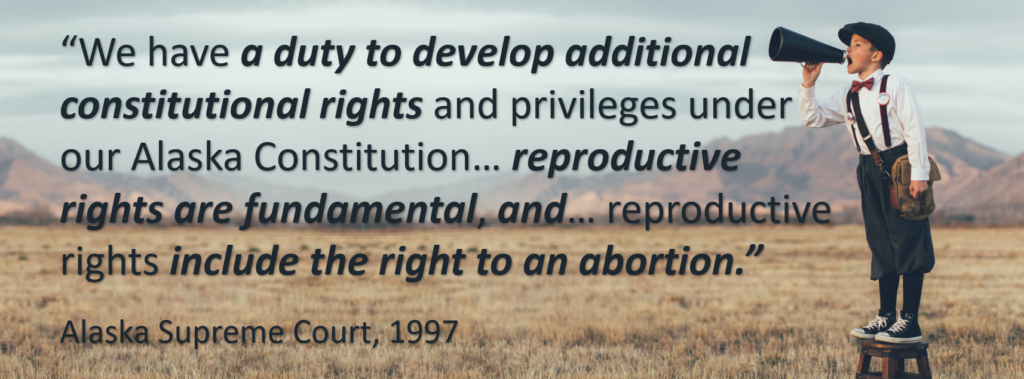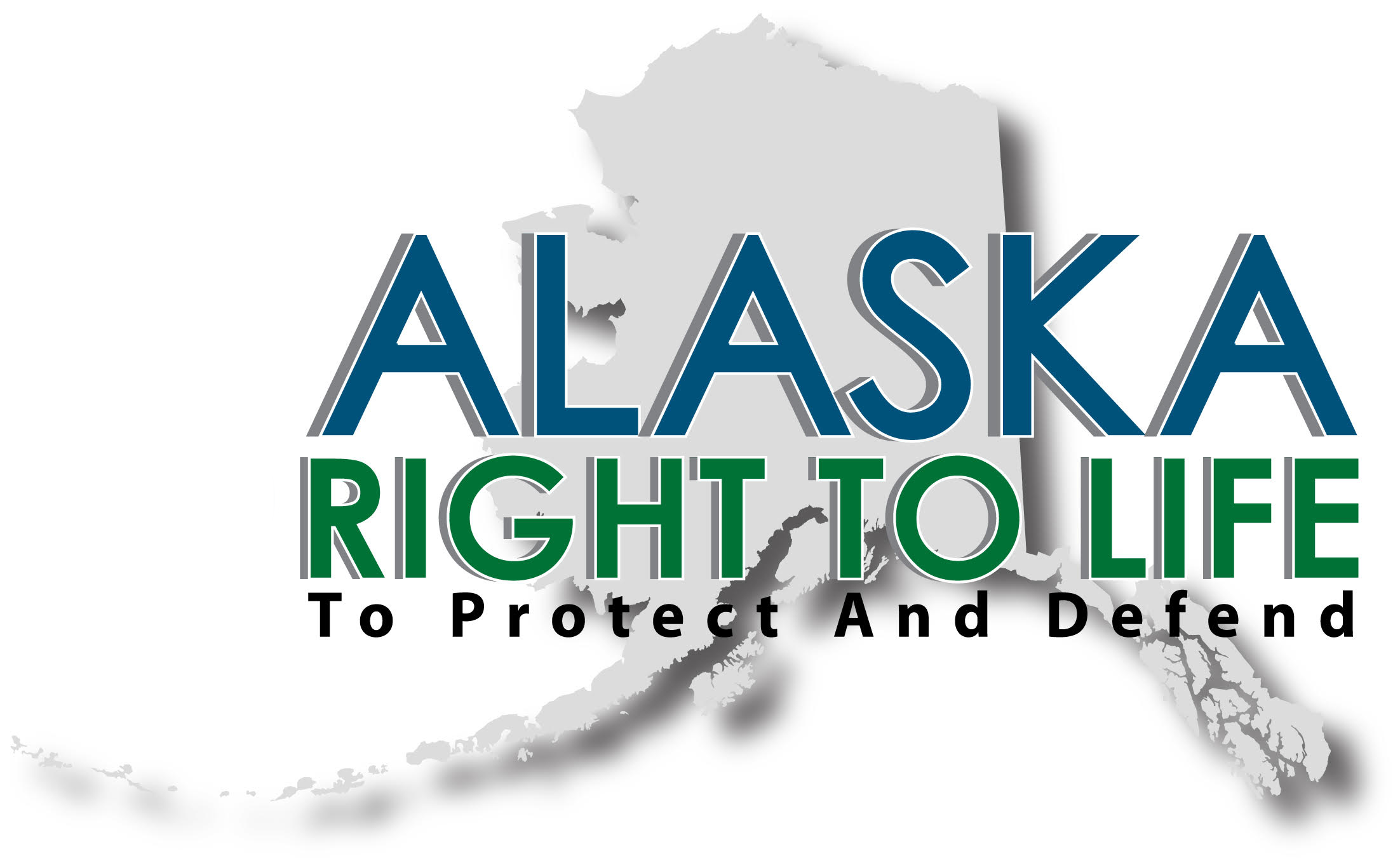INTERPRETING OR AMENDING
ALASKA'S CONSTITUTION?

Even the most liberal constitutional scholars tell us that our courts have the power to treat the constitution as a “living document,” and interpret it in today’s context instead of the original context and intent in which it was written.
And even the most liberal scholar tell us that interpreting the constitution does not empower judges and justices to “develop additional constitutional rights and privileges.”
Amending the constitution is the responsibility of the Legislature and Alaska’s voters, not the Courts.
So did the Courts interpret the Constitution in 1997, or did they amend the Constitution in 1997?
If the Courts interpreted the Constitution in 1997, then we should be able to find references to “reproductive rights,” and “abortion” in the text of the constitution.
BUT WE CANNOT find any references to reproductive rights or abortion in the Constitution.
If the Courts were simply interpreting the Constitution, we would be stuck with their decision until we’re able to introduce a constitutional amendment eliminating “reproductive and abortion rights” in Alaska.
But since there is no reference to “reproductive rights,” or “abortion” anywhere in the Alaska State Constitution, there was clearly no interpretation that would lead Alaska’s Courts to declare a “fundamental and constitutional right to abortion.”
And since Alaska’s Courts obviously AMENDED – changed – the meaning of the Alaska Constitution – in their 1997 decree and decision, they clearly violated the limits of their powers, and the decision itself is UNCONSTITUTIONAL.
Since the decision is unconstitutional, the 2001 decision and order requiring the State to pay for abortions is EQUALLY UNCONSTITUTIONAL, since it was based on the 1997 declaration that abortion is a “fundamental and constitutional right.”
So what do we do now that we know the Courts violated the Constitution – broke the law – in their 1997 decree and decision? How do we stop paying for abortions now that we recognize the decrees, decision, and court orders are unconstitutional?
Read on!
Abortion Law & The Courts
How Alaska’s Courts’ abuse of power has cost tens of thousands of lives
When societies lose sight of the fact that all human life is sacred, made in the image of God, the cascade of events that lead to the dehumanization of entire classes of people is inevitable.
When the Alaska Legislature overturned Governor Miller’s veto of their bill legalizing abortion in Alaska, they took massive steps departing from all moral and cultural norms in America.
After the painful lessons of the emancipation of people held as slaves, Civil War, and the return of those peoples’ rights otherwise guaranteed and protected by the U.S. Constitution, a wave of anti-abortion laws were passed across the United States in the late 1900’s.
Those laws were introduced and adopted into every state to protect the lives of children not yet born, based on the recognition that all human life is sacred, created by God in His image, and to be protected accordingly.
The Right to Life and Abortion
In 1997 the “Fundamental Right to an abortion” was introduced by Alaska Supreme Court Chief Justice Compton.
By creating this new “fundamental right to an abortion,” the Alaska Supreme Court abused the limits on their power as outlined in Alaska Constitution under:
Article 1, Section 1
This constitution is dedicated to the principles that all persons have a natural right to life, liberty, the pursuit of happiness, and the enjoyment of the rewards of their own industry; that all persons are equal and entitled to equal rights, opportunities, and protection under the law; and that all persons have corresponding obligations to the people and to the State.
Article 1, Section 2
All political power is inherent in the people. All government originates with the people, is founded upon their will only, and is instituted solely for the good of the people as a whole.
Article 1, Section 3
No person is to be denied the enjoyment of any civil or political right because of race, color, creed, sex, or national origin. The legislature shall implement this section.
Article 1, Section 22
The right of the people to privacy is recognized and shall not be infringed. The legislature shall implement this section.
Article 13, Section 1
Amendments to this constitution may be proposed by a two-thirds vote of each house of the legislature. The lieutenant governor shall prepare a ballot title and proposition summarizing each proposed amendment, and shall place them on the ballot for the next general election. If a majority of the votes cast on the proposition favor the amendment, it shall be adopted. Unless otherwise provided in the amendment, it becomes effective thirty days after the certification of the election returns by the lieutenant governor.
The setting was the Valley Hospital v. Mat-Su Coalition for Choice lawsuit that made its way to the Alaska Supreme Court by appeal. In their decision, the Supreme Court affirmed the Superior and Appeals Court decisions that women have a constitutional right to kill their children before they are born.
The decision made several significant departures from both Statute and the State Constitution.
Regarding Statute, the Legislature legalized abortion in 1970 by overturning Governor Keith Miller’s veto of their bill. The statute, and its changes allowed women to kill the children in their wombs up to the point of viability. The Supreme Court struck this limitation down and opened abortion to all nine months of pre-born life.
Regarding the Constitution, there’s much more to learn below.
Amendments to this constitution may be proposed by a two-thirds vote of each house of the legislature. The lieutenant governor shall prepare a ballot title and proposition summarizing each proposed amendment, and shall place them on the ballot for the next general election. If a majority of the votes cast on the proposition favor the amendment, it shall be adopted. Unless otherwise provided in the amendment, it becomes effective thirty days after the certification of the election returns by the lieutenant governor.

Constitution of The State of Alaska
Article 13, Section 1
The Alaska Constitution clearly states that amendments to the constitution are the duty of the Legislature and the people. However, in Valley Hospital v. Mat-Su Coalition for Choice, the Alaska Supreme Court claimed this power as their own when they created a new, “fundamental” and “constitutional right,” since the creation of a new right is explicitly an amendment to the constitution.
The Court went further than just interpreting the 1970 legislature’s intent on abortion statute, it actually claimed the constitutional power, authority, and duty to create new rights:
[W]e are under a duty to develop additional constitutional rights and privileges under our Alaska Constitution if we find such fundamental rights and privileges to be within the intention and spirit of our local constitutional language and to be necessary for the kind of civilized life and ordered liberty which is at the core of our constitutional heritage. (emphasis added)

Alaska State Supreme Court
Valley Hospital Association v. Mat-Su Coalition For Choice, 1997In that single, stunning statement, we see the Court take the power to amend the Alaska Constitution from the Legislature and the people of Alaska.
Amendments to this constitution may be proposed by a two-thirds vote of each house of the legislature. The lieutenant governor shall prepare a ballot title and proposition summarizing each proposed amendment, and shall place them on the ballot for the next general election. If a majority of the votes cast on the proposition favor the amendment, it shall be adopted. Unless otherwise provided in the amendment, it becomes effective thirty days after the certification of the election returns by the lieutenant governor.

Constitution of The State of Alaska
Article 13, Section 1The Court continued their theft of constitutional power by proclaiming the right to abortion is protected by Alaska’s constitutional right to privacy under Article 1, Section 22 – authority that is reserved for the Legislature.
We hold that Article 1, section 22 of the Alaska Constitution encompasses reproductive rights, including abortion."

Alaska State Supreme Court
Valley Hospital Association v. Mat-Su Coalition For ChoiceHere we see the Court abusing Article 1, Section 22 of the Alaska Constitution by including abortion in the definition of privacy. However, the Court overstepped its bounds again and claimed powers strictly reserved for the Legislature.
The right of the people to privacy is recognized and shall not be infringed. The legislature shall implement this section.

Constitution of The State of Alaska
Article 1, Section 22Clearly, the power to implement – to define, enforce, and protect – the peoples’ right to privacy is the sole authority and responsibility of the legislature.
It’s clear the Courts created the so-called right to abortion in the Valley v. Coalition decision and opinion.
It’s clear the Courts assumed the power of the legislature, the people, and the Lieutenant Governor when it created the so-called “fundamental” and “constitutional right to abortion.”
It’s clear the Courts assumed legislative powers when defining the right to privacy in Article 1, Section 22 to encompass abortion.
It’s clear that all abortion funding cases point to the “fundamental, constitutional right to abortion” manufactured in this case, and that the fundamental, constitutional right to abortion is based on the Courts’ abuse of legislative, executive, and voting power to amend the constitution and implement Article 1, Section 22.
When societies – and those entrusted with the duty to protect its members – depart from God’s plan for regulating the affairs of men, they inevitably lose the value that God places on every human being.
Alaska began its fall from protecting every human life – including children waiting to be born – three full years before Roe v. Wade led the rest of the country into a maddening destruction of human life never seen before in a civil society.
The way forward requires many steps to be taken: ending abortion funding, redefining the right to privacy to exclude abortion, protecting Alaska’s children from the abortion industry’s influence, and many more.
While we pursue action towards eliminating abortion funding and payments in Alaska, eliminating abortion from our right to privacy, and expelling the abortion industry from our schools and public facilities, The LIFE At Conception Act accomplishes all these goals while focusing the effort on one undeniable fact: LIFE begins at conception.
END THE SPEND
Stop Taxpayer Funded Abortions Today